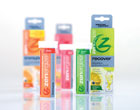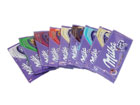
Portability and convenience are the drivers behind effervescent beverage tablets, a new do-it-yourself nutrition-drink category. Source: The Engine Room Inc.
sodium bicarbonate has delivered fizzy pain relief for decades, and now it’s helping define an emerging beverage category. Explaining what the category is and how the product works was the challenge undertaken by the Engine Room Inc., a San Francisco design firm.
Principals/Creative Directors Mike Costifas and Dave Braden designed packaging, point-of-sale displays and collateral material for Zenergize, a line of effervescent tablets that launched in Whole Foods stores in California and Texas on Labor Day.
Zenergize follows the success of Airborne, a dietary supplement sold in the cold-remedy section of drug stores. Zenergize’s creators are targeting consumers of Vitaminwater and other nutritional waters. Marketing director Michelle Arnau of San Francisco-based Bevology describes Zenergize as “vitamin-infused drink tabs. It’s convenient, on-the-go technology” for people who want to “drink their nutrition.”
Ten tablets are stacked in a plastic cylinder, which is packed in a 6x2-inch box that can be merchandised on a pegboard, wire rack or spring-loaded dispenser. “A huge benefit is portability and convenience,” explains Costifas, and he tells the story graphically with an image of a water bottle on the front panel of the box and tablets on the side panel. “We tried to convey that it tastes good, is healthy and hip,” he adds. For more information:
Mike Costifas, the Engine Room Inc., 415-934-8180,
mike@theengineroom.cc
Will the wine age as well as the label?
The application may be naughty, but the label technology is nice in the Mamie Van Doren collection of Sonoma County wines.The one-time blonde bombshell and B-movie starlet is approaching 77 years of age, yet she’s celebrated au naturel on three labels, one depicting her at age 21, the other two of more recent vintage. The limited edition (2,000 each) 1.5-liter bottles sell for $125 each or $300 for the set. “We’ll be sold out before the end of the year,” confidently predicts Dan Laskoski, owner of Wine Country Cellars, the wine’s distributor. “It’s almost strictly an Internet sale.”
The federal Alcohol and Tobacco Tax and Trade Bureau would never allow nude images on a bottle of wine, he says, and “Mamietage” labels feature strategically located peel-away secondary labels. The cover-ups are hinged on one side and coated with a light adhesive to assist in repositioning them over the naughty bits.
Laskoski was inspired by a similar promotion a few years ago featuring Marilyn Monroe on red velvet. The Monroe series sold 30,000 bottles at $200 each. The peel-and-peek labels were designed and engineered by Steve Popelar, president of Dublin, CA-based Label Concepts, a converter and copacker. The concept is similar to on-label instant coupons, he allows, except for the “custom repositional overlay that can be clear or white.” The Van Doren version is a refinement over the Monroe design. “I opened and closed it over 1,000 times,” Popelar reports, “and it worked every time.” Flexographic and digital labels can be made, and a standard labeler can apply them, he adds.
For more information:
Steve Popelar, Label Concepts, 925-828-3444,
stp447@aol.com
Low-maintenance printing
It’s no longer high-tech, but the Focus S10 laser coder in Joe Corbi’s Wholesale Pizza plant in suburban Baltimore is saving money and solving printing issues for the firm.Corbi’s, which specializes in frozen products sold by community fundraising groups, was having problems printing on boxes of cheese bread and cinnamon bread in its Columbia, MD facility. “You had to hit an exact (unlaminated) spot, and even then, the ink might run,” recalls project director Frank Romeo. “The laser is very neat, easy to set up and doesn’t use ink or a ribbon. There is very little maintenance, costs are down, and the price of ink is up.”
Romeo pegs ink savings from each Videojet laser coder at $90 per quarter, plus elimination of eight hours labor in maintenance. Laser isn’t suitable for every application-master cartons of corrugated cardboard require ink-jet printing, for example-but the speed and clean marking of expiration dates and lot codes on primary packaging in a cold environment have made Romeo a fan of the technology. He plans to incorporate lasers in a recently acquired cookie-dough plant in Clear Lake, IA.
Faster options with more features than the Focus S10 have become available in the last year, according to Paul Schildhouse, laser product manager at Videojet Technologies Inc., Wood Dale, IL. The 10-watt S10 was at the low end of its product group, he notes. “On the other hand, its steered-beam laser drew characters continuously, like a pen, as opposed to a column of dots.”
Videojet’s 3120 model, which replaces the S10, burns up to 1,000 characters a second, Schildhouse says. There also are 30-watt and 50-watt models, with double the speed. In some plants, up to 72,000 bottles an hour are being coded, he says. u
For more information:
Paul Schildhouse, Videojet Inc., 630-860-7300,paul.schildhouse@videojet.com

Superior hygiene is a not-incidental secondary benefit of a plastic flow-wrapper for Kraft’s Milka candy bars. Source: Huhtamäki Oyj.
Security at a reduced cost
While Kraft Foods was still investigating the source of Salmonella contamination in Baker’s Premium White Chocolate Baking Squares a week after products were pulled from US and Canadian store shelves in early October, post-packaging contamination could have been ruled out if barrier film had been used.The transition from paper and foil to more effective oriented polypropylene plastic (OPP) already is underway in Kraft’s European operations. The company’s Milka chocolate bars recently became the first major EU conversion to cold-seal flow wrappers of OPP film from Huhtamäki Oyj’s Ronsberg, Germany operations. To ramp up film supplies, the German plant installed an 11-color rotogravure printer on its film lamination line.
“Some microbes could make it through an aluminum and paper wrapper,” observes Martin Hauck, Huhtamäki’s marketing director flexibles Europe. “Because this package is all plastic, it is a hermetic seal.”
Food safety claims are limited to odor and external contamination protection, of course, though the supplier is touting the package’s hygienic reclosability. The easy-peel opening can be pressed closed several times, a useful feature with larger candy bars. Hauck likened the technology to a Post-It note.
The change means material savings and faster wrapping speeds, but cost was only one reason for the switch, an executive with Kraft Europe explained. Protection against insects and other food safety considerations were factors, plus the switch to a more modern look and the reduced carbon footprint achieved by eliminating aluminum. But obesity concerns were perhaps the overarching reason. Two bar sizes are available, including 100 gram (3.5 oz.) and 300 gram (10.6 oz.). “Portion control is a big issue,” the executive explained, “particularly with the larger bar. The package can be resealed five times or more, and that encourages people not to eat it all at once.”
Milka bars have a 100-year history. Foil and paper have protected it for much of that time. The candy is produced at plants in Loerrach, Germany and Bludenz, Austria.
For more information:
Martin Hauck, Huhtamäki Group, 011-49 8306 77-346,
martin.hauck@de.huhtamaki.com